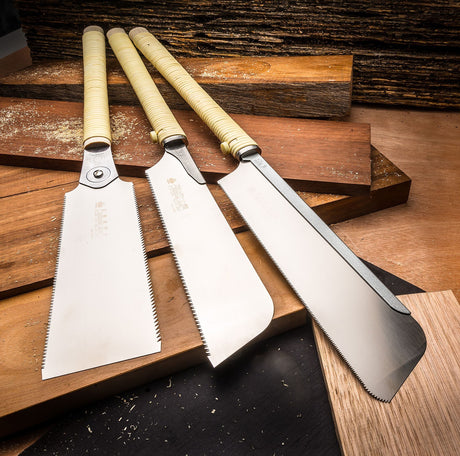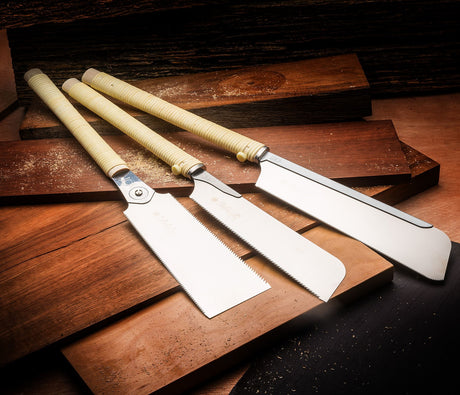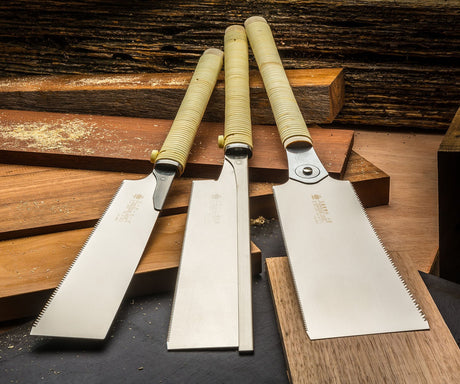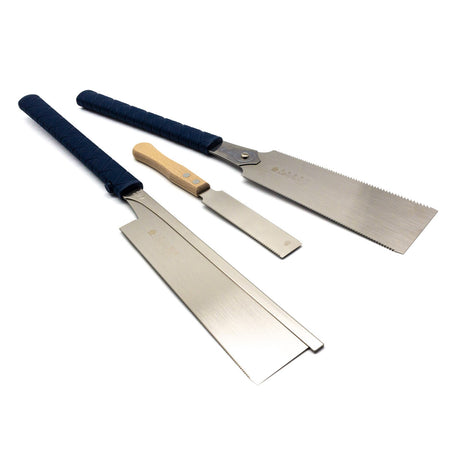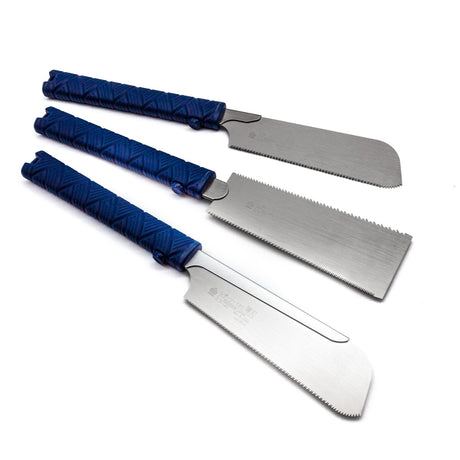Razorsaw
Razorsaw Japanese Saw General Purpose Set Dozuki Kataba Ryoba
$169.90$190.70Unit price /UnavailableIn stockRazorsaw
Razorsaw Fine Woodwork Japanese Saw Set Dozuki Kataba Ryoba
$179.90$199.70Unit price /UnavailableIn stockRazorsaw
Razorsaw Japanese Saws Woodworkers Shop Set of Four Ryoba Dozuki Kataba Flush Cut
$219.90$246.60Unit price /UnavailableIn stockRazorsaw
Razorsaw Handy Japanese Saw Set of Three Ryoba Dozuki Flush Cut
$139.90$160.70Unit price /UnavailableVery low stock (1 unit)Razorsaw
Razorsaw Miniature Japanese Saw Fine Woodwork Set Dozuki Kataba Ryoba
$135.00$148.70Unit price /UnavailableVery low stock (1 unit)Razorsaw
Razorsaw Miniature Japanese Saw General Purpose Set Dozuki Kataba Ryoba
$125.00$137.70Unit price /UnavailableIn stockMitsukawa
Mitsukawa Japanese Detail Saws Set of 5 in Canvas Roll Dozuki Kataba Ryoba Keyhole Flush Cut
$599.90Unit price /Unavailable
Japanese Saw Sets for Precision, Control and Clean Cutting
Japanese saw sets are prized by woodworkers around the world for their incredible sharpness, fine kerf, and pull-stroke cutting action. Unlike Western saws that cut on the push stroke, Japanese saws cut on the pull, allowing for thinner blades, cleaner cuts, and greater control, making them ideal for joinery, cabinetry, and intricate woodworking projects.
Most Japanese saw sets include a combination of Ryoba, Dozuki, and Kataba saws. The Ryoba features two cutting edges—one for crosscutting and one for ripping—making it highly versatile. The Dozuki has a reinforced spine for highly accurate dovetail or tenon cuts, while the Kataba is a single-edge saw perfect for deep or flush cuts without the spine limiting depth.
Crafted from high-carbon steel with impulse-hardened teeth, Japanese saws maintain their edge well and leave an impressively smooth surface that often requires little sanding. Many sets now include interchangeable blades or replaceable heads, allowing for extended use without the need for frequent sharpening.
Whether you're a furniture maker, a beginner learning hand tool joinery, or a detail-oriented craftsperson, a Japanese saw set brings precision and tradition to your workshop. They’re lightweight, easy to handle, and an excellent addition to any hand tool collection.
FAQs
What makes Japanese saws different from Western saws?
Japanese saws cut on the pull stroke, allowing for thinner, more flexible blades that produce finer kerfs and require less effort. Western saws cut on the push stroke and typically use thicker, stiffer blades.
What types of saws are usually included in a Japanese saw set?
Common Japanese saw sets include a Ryoba (dual-edge for rip and crosscuts), a Dozuki (backed saw for precise joinery), and a Kataba (single-edge saw for flush or deep cuts). Some sets may include flush-cut saws or folding handles as well.
Are Japanese saws good for beginners?
Yes, many beginners find Japanese saws easier to control due to the pull stroke action. Their thin blades and sharp teeth make it easier to follow layout lines and achieve accurate, clean cuts without excessive force.
Do Japanese saws need to be sharpened?
Most Japanese saws feature impulse-hardened teeth, which stay sharp for a long time but cannot be re-sharpened. When dull, the blade is typically replaced. Some traditional saws with non-hardened teeth can be sharpened with the right files.
Can I use a Japanese saw for hardwoods?
Absolutely. Japanese saws handle hardwoods well, especially when using a Dozuki or Kataba. Just ensure the teeth pattern is appropriate—fine teeth for clean cuts in hardwood, coarser teeth for faster removal in softwood or larger stock.
What is the best saw in the set for dovetail joints?
The Dozuki saw is the most suitable for dovetail joints due to its stiff spine, ultra-fine teeth, and ability to make precise, straight cuts along layout lines. It excels at joinery where accuracy is critical.
Are replacement blades available for Japanese saws?
Yes, many modern Japanese saws come with removable or replaceable blades, which is convenient when the teeth become dull. This also reduces waste and cost compared to buying entirely new saws.
Do Japanese saws require special care or storage?
To prolong their lifespan, keep Japanese saws clean and dry, and store them with a blade guard or in a protective case. Avoid forcing them through cuts or using them on inappropriate materials like nails or screws.

